
Title means "Quietness", "Comfortable Sound" and "Excellent Acoustics"
Nagata Acoustics News 03-04 (No.184)
Issued : April 25, 2003
Toka Music Hall Opens in Kurashiki's "Creative Town Okayama"
by Chiaki Ishiwata
Stage view
© AKIO NONAKA
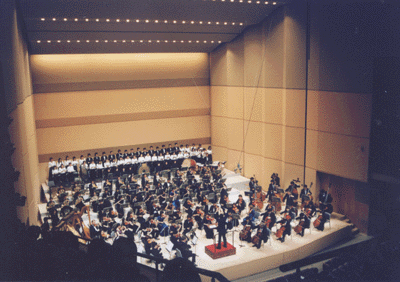 |
On October 30, 2002, Kurashiki Sakuyo University (in Kurashiki City, Okayama Prefecture) held the inaugural concert of its long-desired and long-awaited Toka Music Hall , marking the successful completion of this facility two decades after it was first envisioned. Toka Music Hall is an 800-seat, shoebox-configuration, multipurpose hall with acoustic shell. The hall is intended primarily for the university's music students, who will use it for both instruction and performances. Additionally, it will also serve as the venue for a variety of other performing arts activities.
<< The University's Origins as a Conservatory in Tsuyama City >>
Kurashiki Sakuyo University began as Sakuyo Music College and was located in the Okayama Prefecture's Tsuyama City. In April 1997, the college relocated to its present site atop a small hill that is just a 10-minute walk from Shin-kurashiki Station. The following year, a culinary college was added and the combined institution became Kurashiki Sakuyo University.
<< The Final Phase of a Four-part Project >>
Yoshimura Architect created the architectural design for the entire Kurashiki campus, and the campus' construction was implemented through a master plan that spanned four projects. The fourth and last project included Toka Music Hall plus two other buildings. One of the buildings constructed in an earlier project is another hall, named Shotoku Music Hall, which has a pipe organ. Because the buildings' architectural designs and construction were comprehensively planned at the outset, the whole campus has a well-arranged and unified appearance.
<< Posthumous Realization of Architect Yoshimura's Design >>
Drawing of section
© YOSHIMURA ARCHITECT
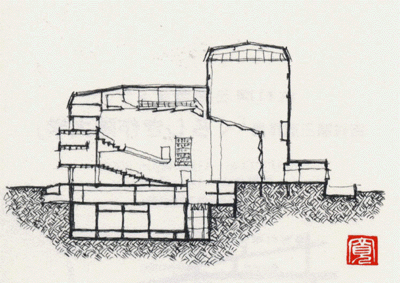 |
The idea of constructing a hall for Sakuyo University originated many years ago, when the university was still a music college in Tsuyama and the late Maestro Akio Watanabe was the college's president. With Maestro Watanabe's recommendation, the college commissioned architect Junzo Yoshimura to design a hall for the school. Mr. Yoshimura saw his design through to the completion of the hall's construction documents in 1983, but actual construction never began because, thereafter the college moved to the new Kurashiki campus.
Now, with the location for the hall's plans having been successfully changed to Kurashiki, and after the passage of two decades, Mr. Yoshimura's design for Toka Music Hall has become a reality. The hall's interior is mostly drywall covered with wood veneer and painted gradations of color in hues that are typical of Mr. Yoshimura's architectural design. Nagata Acoustics provided the acoustical consulting for the hall's original design intended for the Tsuyama campus and again served as the acoustical consultant for the new construction in Kurashiki. Hisanori Fujimoto provided the stage consulting expertise on the project.
<< Constructing a Hall from Plans Two Decades Old >>
For this project, we adhered to the university's request that the hall be built according to the original plans developed for the Tsuyama campus. However, in order to give the hall appropriate functionality to satisfy today's standards and needs, a number of aspects of the original specifications required reconsideration. For example, because the school has added course offerings in traditional Japanese performing art genres and in musicals, changes were made to the hall's stage functionality and the backstage area was expanded. The project also including reviewing and upgrading the original design's machinery and equipment specifications for the building to bring them up to current technology and construction standards.
<< Reconsidering the Hall's 20-year Old Acoustical Design >>
In reviewing Toka Music Hall 's acoustical design as well, we compared the original design with current methodologies. The past 20 years have seen spectacular changes in the state of hall acoustical design in Japan. It was an era that included the advent of specialty concert halls, the proliferation of hall construction throughout the nation and a marked increase in appreciation and awareness of hall acoustics. Our reconsideration of the hall's original acoustical design took into consideration the changes of the past two decades and we adapted both the acoustical design and related construction design elements in accordance with today's methodologies and technologies.
<< Changes to the Hall's Room Acoustical Design >>
Our changes to the design of the hall's room acoustics focused on two items: maximizing the hall's spatial volume and achieving a unified feeling between the stage and the audience seating area. To support both of these goals, we altered the height of the stage's proscenium opening. The hall's original design, which focused on acoustics for musical performances, specified an above-audience ceiling height that was quite high for designs of that era. The specifications called for the ceiling above the audience seating area to be 15 m. (49 ft) high (measured from the height of the stage floor). We mostly preserved this original specification and modified the proscenium's dimensions to create a smooth transition between the ceiling above the audience seating and the ceiling above the stage.
We changed the height of the stage proscenium from its original 10.8 m. (35 ft) to 13 m. (43 ft) and we also changed the height of the front panel of the acoustical shell from 7 m. (33 ft) to 10 m. (33 ft). In addition, we made minor modifications to the angle and height of the ceiling above the audience seating area. As a result of this combination of changes to the specifications of the hall's room acoustical design, we increased the hall's spatial volume, achieving an overall volume of 8,000 cu. m. (282,517 cu. ft).
Our 20-year-old office file on Toka Music Hall contained hand-written, 2-dimensional studies of expected sound reflection paths. This time, we used 3-dimensional computer simulations to study and investigate how sound would travel depending on variations in the hall's configuration.
<< Changes to the Hall's Noise Control Specifications >>
The original acoustical design specifications of 20 years ago required that the noise from the hall's HVAC system and other machinery generate a level of noise no louder than NC-25. We changed this specification to require that the noise level be no higher than NC-20. Currently, music concert specialty halls are all achieving a quietness of NC-15, and for multipurpose halls, since they also serve as venues for music concerts, the bar has been raised as well, with current expectations at NC-20. We based our revised specifications for Toka Music Hall on what would be expected for a multipurpose hall being designed today.
<< Impressions of the Hall's Sound from the Inaugural Concert >>
Audience view
© AKIO NONAKA
 |
At Toka Music Hall 's inaugural concert, the university's Chief Musical Advisor, Maestro Hiroyuki Iwaki, conducted a joint performance by the Sakuyo University Orchestra and the professional Orchestra Ensemble Kanazawa. The program included the premiere performance of "Fan-Faring," a piece for orchestra and mixed chorus, composed by Shinichiro Ikebe and commissioned by the university for the occasion. In addition, during the program's interlude, Maestro Iwaki and Composer Ikebe charmed the audience with witty conversation.
Toka Music Hall does not have the kind of long reverberation time one finds in large-scale concert halls, but it has an honest sound that suits the size and scale of the facility. I am told that the hall has a fine reputation among its performers, and the university's Professor Yasuo Watanabe, who teaches piano, told me that the hall is especially good for piano music. Students in the university's Arts Management program handled the inaugural concert's stage preparations and other behind-the-scenes tasks, giving them hands-on experience in hall management.
<< Toka Music Hall 's Role in the Training of Young Concert Musicians >>
While the hall has now been in operation since last autumn, it still remains known to only a relatively small number of people. It will be exciting to watch as the student musicians gain experience in the hall and develop their abilities to perform in a live concert environment.
Later this year, the Fifth International Tchaikovsky Competition for Young Musicians will be held in Kurashiki. Toka Music Hall and Shotoku Music Hall will serve as the venues for the event. This will surely increase the general music world's awareness of the new and long-awaited Toka Music Hall. For more information about the competition, please go to the competition's website at http://www.tchaikovsky-competition.org/. The university's website has a schedule, in Japanese only, at http://www.ksu.ac.jp.
Sound Absorption System of Perforated Panels with a Screen Strip Overlay
by Dr. Keiji Oguchi
The sound absorption characteristics of perforated panel sound absorption systems can be varied by changing the thickness of the panels, the density of perforations and/or the depth of the air layer behind the panels. These systems are used in various interior locations to control noise and tune room acoustics. In particular, these systems are frequently used in the design of halls, music studios and music practice rooms as a means to absorb sound evenly and effectively across broad frequency range in order to achieve the desired reverberation time in the room and to prevent acoustically detrimental echoes and sound focusing.
Incidental to the use of the perforated panels for acoustical design reasons, but pertinent to this discussion, is their use to protect archtecturally soft, porous materials such as glass wool, and their implementation for visual, interior design reasons. However, even though perforated panels are considered to be a finishing surface for interiors, when viewed at close range, the inside of the perforations become visible and when viewed at a distance there is a contrast between the color of the perforations and the non-perforated areas of the panel. Often, interior designers say they prefer that the sound absorption system have a consistent and uniform appearance instead of the two-tone appearance of the perforated panels.
Some alternatives to perforated panel sound absorption systems exist, specifically, Copenhagen ribbing, aluminum fiber panels and absorbent ceramics. However, the absorption frequency ranges of these alternatives, prohibitive cost and other reasons mean that, when large surface areas must be covered, the options for even and uniform sound absorption remain very few.
<< A New Option for Perforated Panel Sound Absorption Systems >>
Perforated plate absorption system
with blind screen
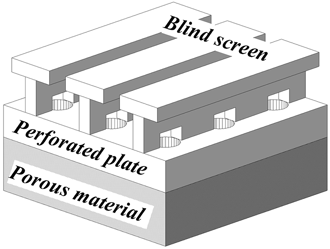 |
For some time now, I have been engaged in research and experiments to expand the options for sound absorption systems that can be implemented as the interior finishing of large surface areas. The new alternative I have researched places a layer of three-dimensional strips in front of the perforated panels to hide the perforated surfaces from view. The perforated panels used in this alternative are backed by glass wool and an air layer.
My interest in this topic began with one of my visits to the office of Professor Kyoji Fujiwara, a professor of acoustical design and engineering at the Kyushu Institute of Design. Professor Fujiwara showed me samples he had lined up of perforated panels, each covered with a configuration of wood strips, and he shared with me the results of tests revealing that at mid-range frequencies, the covered panels exhibited sound absorption characteristics close to the characteristics of perforated panels without the openwork coverings.
<< Researching the Periodicity of Perforations and Screen Strip Overlays >>
Because there are periodic relationships between the panel perforations and between the wood strips of the overlays, I was able to investigate a method for calculating the sound absorption characteristics based on the periodicities of the perforations and the wood strips. Using the method I developed, it is now possible to predict, with some degree of precision, the sound absorption characteristics for any configuration that uses a periodic sound absorbing structure. In the rest of this article, I will summarize some highlights of my research to date.
<< Calculating the Sound Absorption of a Periodically Uneven Surface >>
Let me begin my explanation by starting with a perforated panel sound absorption system with broad-band absorption characteristics. The perforation panels have a 20% density of perforations and are backed by glass wool behind which is an air layer at least 300 mm. (12 in.) deep. The absorption mechanisms at work here are a combination of: (1) Helmholtz resonance (for the mid-to-low range frequencies) due to the layering of a large air layer behind the perforations; and (2) the air layer's repeated pipe resonances (for the mid-to-high range frequencies). Through my research, I discovered that even when I placed an overlay of screen strips on the perforated panels, at mid-range frequencies the sound absorption characteristic continued to exhibit a peak centering on the resonance frequencies of the perforated panel sound absorption system. However, the addition of the overlay of screen strips causes the phenomenon of the resonance frequencies shifting in the direction of lower frequency ranges. Also, when I placed the screen strip overlay so that it was separated from the perforated panels by 10-to-20 mm. (0.4-to-0.8 in.), sound absorption also undeniably occurred at high frequencies of 2 kHz and above. This sound absorption was likely the result of resonance produced by the slits of the screen strip overlay.
The absorption frequency ranges of the perforated panels under the overlay, and of the slits of the screen strip overlay both occur periodically, whether they are due to the arrangement of perforations or of the screen strips. For frequencies near the respective absorption ranges of both the perforated panels and the screen strip overlay, the absorption coefficient is large, approaching 1. Based on these findings, therefore, I developed the hypothesis that by adding periodic openings having resonances of different frequencies it would be possible to achieve either absorption coverage for a broader band of frequencies or a more even absorption characteristic.
<< Tests of Existing Perforated Panel Configurations >>
To compare my hypothesis with existing sound absorption systems, I investigated the absorption characteristic of a perforated panel having openings of two different sizes occurring evenly in a periodic pattern. Specifically, I used a repeating pattern of holes arranged like the number five on one die (of a pair of dice), and in which the outer four holes were each 8 mm. (0.3 in.) in diameter and set at 15 mm. (0.6 in.) intervals, the middle hole was 6 mm. (0.2 in.) and an extra 6 mm. (0.2 in) hole, aligned with the middle hole, repeated between each "number five." The 6 mm. (0.2 in.) holes were also placed at 15 mm. (0.6 in.) intervals from each other, and the entire ratio of perforated to non-perforated area was about 35%. I also tested a sound absorption system that uses perforated panels having these two sizes of holes in a checkered pattern (with intervals of 15 mm. (0.6 in.) between holes). This arrangement would clearly have a large absorption coefficient for mid-range frequencies. However, with the checkered pattern, as holes are added the ratio of perforated to non-perforated surface increases, and the result is that this causes the absorption characteristic of the glass-wool backing to affect the absorption frequency range.
<< Sound Absorption Benefits of the Screen Strip Overlay >>
Perforated plate absorption system
with 2 kinds of holes in the check state,
covered with screen strips
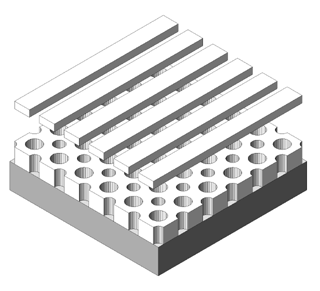 |
I then tested a configuration with a screen strip overlay in front of the perforated panel. The screen strip overlay added high frequency range absorption due to the resonance of the slits between the overlay strips, and this sound absorption system exhibited both absorption for a broad band of frequencies and a high absorption coefficient. In particular, when compared with systems using the 8 mm. (0.3 in.) diameter holes at intervals of 15 mm. (0.6 in.) typical of perforated panel systems having a high ratio of perforated to non-perforated surface area, a noteworthy characteristic of the screen strip overlay system is its high absorption performance at high frequency ranges of 1000 Hz and above.
In addition, if perforated panels with single-size holes are used to make a sound absorption system intended for a broad band of 300 Hz - 3kHz, the air layer behind the porous backing of the perforated panels must be on the order of 200 mm. (8 in.) deep. With the screen strip overlay system introduced here, the air layer behind the porous backing is just 50 mm. (2 in.). Therefore, another notable characteristic of the screen strip overlay system is that it offers broad-band sound absorption without requiring a large space behind the system for use as the air layer.
In order to confirm my hypothesis regarding the broad-band absorption characteristic of the screen strip overlay system, I performed a test in which I measured the actual absorption coefficient. The results I obtained tracked almost exactly to my calculations, thereby verifying the sound frequency absorption range that my hypothesis predicted.
<< Visual Appearance of the Screen Strip Overlay >>
The addition of the three-dimensional screen strip overlay mostly hides the panel perforations from view, although the perforations remain visible when the system is viewed from certain diagonal perspectives. I made a large overlay sound absorption panel to measure the sound absorption characteristics achieved in a reverberation chamber and when this panel is placed under normal room lighting, the perforations behind the screen strip overlay are, for all practical purposes, entirely hidden from view because the strips of this overlay are arranged at comparatively dense intervals. Therefore, it is fair to say that the screen strip overlay sound absorption system I developed hides the perforations of the perforated panels from view.
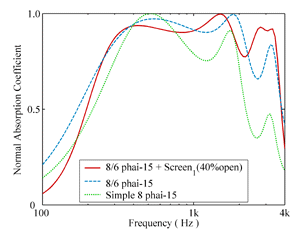 | 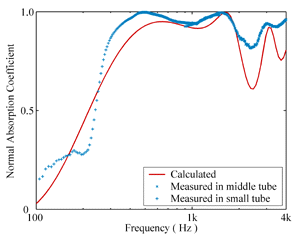 |
Calculated absorption characteristics of
some perforated absorption system | Comparison of calculated and
measured absorption characteristics,
8/6 phai-15 + Screen_2 (40%open) |
I would be very pleased to receive comments, questions or other communications from anyone interested in using this alternative sound absorption system, or interested in more information on the special characteristics of the system, as well as from anyone with specific requests or concerns about the prediction of absorption characteristics for periodical systems.
Editor's note:
In March 2003, Keiji Oguchi received his Doctorate in Design from the Kyushu Institute of Design. This article is based on his doctoral dissertation.
E-mail Distribution of Nagata Acoustics News & Opinions
We hope you have enjoyed this News & Opinions newsletter, available each month on our web-site (http://www.nagata.co.jp). We also offer e-mail delivery of the text version of this newsletter. To receive the text newsletter to your e-mail address, simply send the following information to us at newsmail_e@nagata.co.jp:
(1) Your e-mail address
(2) Your name
(3) The name of your company
By requesting the text version via e-mail, you will automatically receive every newsletter and you can still get the visuals and graphics at our web-site.
Nagata Acoustics News 03-04(No.184)
Issued : April 25, 2003
Nagata Acoustics Inc.
Hongo Segawa Bldg. 3F, 2-35-10
Hongo, Bunkyo-ku, Tokyo 113-0033 Japan
Tel: +81-3-5800-2671, Fax: +81-3-5800-2672
E-mail: info@nagata.co.jp









